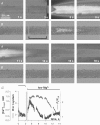Store-operated Ca2+ entry during intracellular Ca2+ release in mammalian skeletal muscle
- PMID: 17569733
- PMCID: PMC2277221
- DOI: 10.1113/jphysiol.2007.135046
Store-operated Ca2+ entry during intracellular Ca2+ release in mammalian skeletal muscle
Abstract
Store-operated Ca2+ entry (SOCE) is activated following the depletion of internal Ca2+ stores in virtually all eukaryotic cells. Shifted excitation and emission ratioing of fluorescence (SEER) was used to image mag-indo-1 trapped in the tubular (t) system of mechanically skinned rat skeletal muscle fibres to measure SOCE during intracellular Ca2+ release. Cytosolic Ca2+ transients were simultaneously imaged using the fluorescence of rhod-2. Spatially and temporally resolved images of t system [Ca2+] ([Ca2+]t-sys) allowed estimation of Ca2+ entry flux from the rate of decay of [Ca2+]t-sys. Ca2+ release was induced pharmacologically to activate SOCE without voltage-dependent contributions to Ca2+ flux. Inward Ca2+ flux was monotonically dependent on the [Ca2+] gradient, and strongly dependent on the transmembrane potential. The activation of SOCE was controlled locally. It could occur without full Ca2+ store depletion and in less than a second after initiation of store depletion. These results indicate that the molecular agonists of SOCE must be evenly distributed throughout the junctional membranes and can activate rapidly. Termination of SOCE required a net increase in [Ca2+]SR. Activation and termination of SOCE are also demonstrated, for the first time, during a single event of Ca2+ release. At the physiological [Ca2+]t-sys, near 2 mM (relative to t system volume), SOCE flux relative to accessible cytoplasmic volume was at least 18.6 microM s(-1), consistent with times of SR refilling of 1-2 min measured in intact muscle fibres.
Figures









Comment in
-
Store-operated Ca2+ release in skeletal muscle: tailored for a specialized system.J Physiol. 2007 Aug 15;583(Pt 1):1. doi: 10.1113/jphysiol.2007.139923. Epub 2007 Jul 12. J Physiol. 2007. PMID: 17627981 Free PMC article. No abstract available.
Similar articles
-
Confocal imaging of [Ca2+] in cellular organelles by SEER, shifted excitation and emission ratioing of fluorescence.J Physiol. 2005 Sep 1;567(Pt 2):523-43. doi: 10.1113/jphysiol.2005.087973. Epub 2005 Jun 9. J Physiol. 2005. PMID: 15946962 Free PMC article.
-
The changes in Ca2+ sparks associated with measured modifications of intra-store Ca2+ concentration in skeletal muscle.J Gen Physiol. 2006 Jul;128(1):45-54. doi: 10.1085/jgp.200609545. Epub 2006 Jun 12. J Gen Physiol. 2006. PMID: 16769796 Free PMC article.
-
Mechanistic insights into store-operated Ca2+ entry during excitation-contraction coupling in skeletal muscle.Biochim Biophys Acta Mol Cell Res. 2019 Jul;1866(7):1239-1248. doi: 10.1016/j.bbamcr.2019.02.014. Epub 2019 Feb 27. Biochim Biophys Acta Mol Cell Res. 2019. PMID: 30825472
-
Ryanodine receptor activity and store-operated Ca2+ entry: Critical regulators of Ca2+ content and function in skeletal muscle.J Physiol. 2023 Oct;601(19):4183-4202. doi: 10.1113/JP279512. Epub 2022 Mar 16. J Physiol. 2023. PMID: 35218018 Review.
-
Toward the roles of store-operated Ca2+ entry in skeletal muscle.Pflugers Arch. 2010 Oct;460(5):813-23. doi: 10.1007/s00424-010-0856-7. Epub 2010 Jun 25. Pflugers Arch. 2010. PMID: 20577885 Review.
Cited by
-
Hypertrophy in skeletal myotubes induced by junctophilin-2 mutant, Y141H, involves an increase in store-operated Ca2+ entry via Orai1.J Biol Chem. 2012 Apr 27;287(18):14336-48. doi: 10.1074/jbc.M111.304808. Epub 2012 Mar 2. J Biol Chem. 2012. PMID: 22389502 Free PMC article.
-
Dexamethasone stimulates store-operated calcium entry and protein degradation in cultured L6 myotubes through a phospholipase A(2)-dependent mechanism.Am J Physiol Cell Physiol. 2010 May;298(5):C1127-39. doi: 10.1152/ajpcell.00309.2009. Epub 2010 Jan 27. Am J Physiol Cell Physiol. 2010. PMID: 20107037 Free PMC article.
-
Improper Remodeling of Organelles Deputed to Ca2+ Handling and Aerobic ATP Production Underlies Muscle Dysfunction in Ageing.Int J Mol Sci. 2021 Jun 8;22(12):6195. doi: 10.3390/ijms22126195. Int J Mol Sci. 2021. PMID: 34201319 Free PMC article. Review.
-
Accelerated activation of SOCE current in myotubes from two mouse models of anesthetic- and heat-induced sudden death.PLoS One. 2013 Oct 15;8(10):e77633. doi: 10.1371/journal.pone.0077633. eCollection 2013. PLoS One. 2013. PMID: 24143248 Free PMC article.
-
STIM1L is a new actin-binding splice variant involved in fast repetitive Ca2+ release.J Cell Biol. 2011 Jul 25;194(2):335-46. doi: 10.1083/jcb.201012157. J Cell Biol. 2011. PMID: 21788372 Free PMC article.
References
-
- Cheung A, Dantzig JA, Hollingworth S, Baylor SM, Goldman YE, Mitchison TJ, Straight AF. A small-molecule inhibitor of skeletal muscle myosin II. Nat Cell Biol. 2002;4:83–88. - PubMed
Publication types
MeSH terms
Substances
Grants and funding
LinkOut - more resources
Full Text Sources
Other Literature Sources
Research Materials
Miscellaneous

